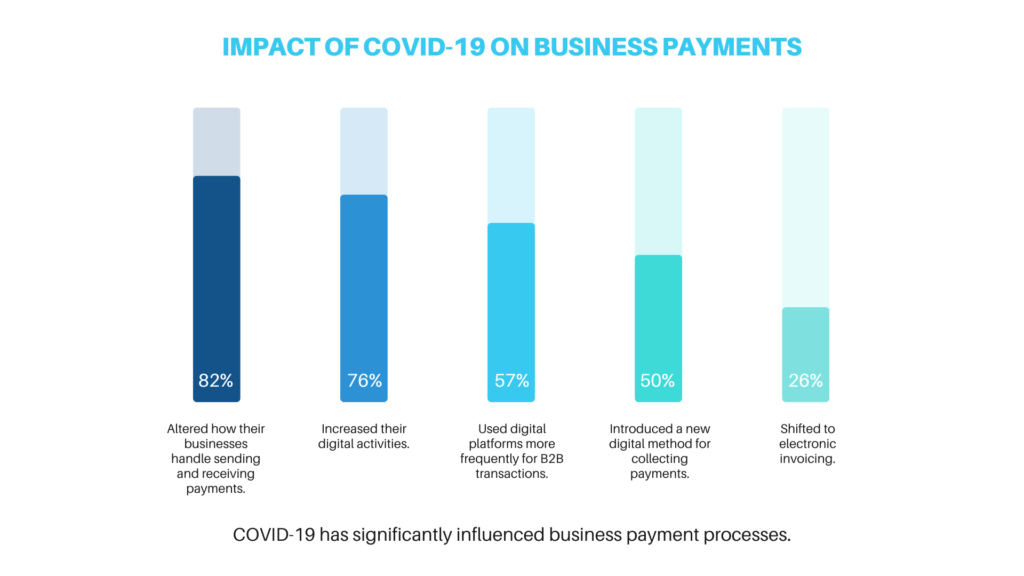
What Is B2b Payments?
In the world of commerce, B2B payments are evolving with faster, real-time processing and stronger security from technologies like blockchain and AI. These advancements help businesses manage cash flow and reduce costs, while regulatory updates are shaping safer, more efficient international payments.
Businesses don’t just interact with customers—they also transact with other businesses. These transactions are known as B2B payments, where one business pays another for goods or services.
B2B payments are important for keeping the supply chain running smoothly, allowing businesses to exchange goods and services smoothly. Unlike regular consumer transactions, B2B payments usually involve larger amounts, more detailed agreements, and payment methods designed to meet business needs.
Most Popular Important Types Of B2b Payments
- Wire Transfers
- ACH (Automated Clearing House) Payments
- Credit Cards
- Digital Wallets
- Electronic Funds Transfer (EFT)
- Virtual Cards
- Checks
1. Wire Transfers
- Why It’s Important: Wire transfers are essential in B2B payments because they provide speed and reliability, especially for high-value and cross-border transactions. By transferring money directly between bank accounts, wire transfers allow businesses to complete urgent or critical payments swiftly, even though they come with higher fees than other methods.
- Use Cases: Common uses include purchasing large equipment, paying international suppliers, and finalizing trade deals.
- ACH (Automated Clearing House) Payments
- What is ACH? ACH, or Automated Clearing House, is a preferred B2B payment method due to its convenience in processing high volumes of transactions. It’s especially useful for recurring payments like payroll, utilities, and fees. ACH transactions are processed in batches, typically taking 1-3 business days to complete.
- Why ACH is Popular: Many organizations choose ACH because it is cost-effective and often free through some banks. This method serves as a smart alternative to paper checks. ACH payments are easy to track, appear on monthly statements, and integrate seamlessly with enterprise systems (like ERP) as part of the electronic funds transfer (EFT) process.
- Limitations: ACH is only available within the U.S. and has a daily cut-off time. If a transaction is missed, it must wait until the next day for processing.
- Use Cases: Common ACH transactions include payroll processing, supplier payments, and utility bill payments.
- Credit Cards
- Why It’s Important: Credit cards simplify B2B transactions, especially for small or daily expenses. They help businesses manage cash flow by allowing them to leverage credit terms, often with long interest-free grace periods. Additionally, many credit cards offer cashback, rewards, or travel points, making them attractive for regular use.
- Purpose: Common uses include office supplies, travel expenses, and supplier purchases.
- Credit cards serve as a primary method for B2B payments, providing a convenient and cost-effective way to facilitate transactions and manage cash flow. Businesses can easily track their spending through electronic or paper statements at month-end.
- While credit cards do have interest rates, like the annual percentage rate (APR), paying off the revolving balance quickly allows businesses to access extra funds. When treated like a debit card and paid off each month, credit cards become a highly beneficial payment option.
- To combat cybercrime, credit card issuers provide one-time use numbers. This feature helps prevent fraud since the number becomes invalid after the first transaction. These virtual credit cards link to the regular credit card number in your account, ensuring all transactions appear on a single statement at the end of the billing cycle.
- Digital Wallets
Why It’s Important: Digital wallets like PayPal, Google Pay, and Apple Pay are becoming popular for B2B payments because they’re quick and easy to use.
They let businesses send money instantly with very little setup. Plus, they include handy features like invoicing and tracking payments, making them great for small businesses and freelancers.
Use Cases: buying and selling online, paying freelancers or small suppliers quickly, and managing subscription services.
- Electronic Funds Transfer (EFT)
- EFT is a large category that includes many digital payment methods such as ACH, wire, and card payments. Corporate organizations use it as an automatic resource for managing domestic and international transactions. Most EFT solutions integrate easily with accounting software, ensuring payments match correctly and keeping financial records up-to-date.
- Use Cases: vendor payments, recurring bill payments, and automated invoice settlements.
- Virtual Cards
- Why Important: Virtual cards are becoming more popular because they offer better security and control. These cards are digital-only and often used just once for specific payments. They create a unique card number for each transaction, which helps prevent fraud and makes it easier for businesses to keep track of spending. They work especially well for online subscriptions and one-time vendor payments.
- Use Cases: Online purchases, subscription payments, and controlled vendor payments.
- Checks
- Even though people use checks less often today, some businesses still prefer them because they can control payment timing more effectively. This is helpful for managing cash flow. Checks are also common in industries that are slower to switch to digital payments or where trust and long-term relationships are important.
- Use Cases: rent payments, large contracts with suppliers, and payments in industries like construction or manufacturing.
Why Use B2B Payments?
B2B (Business-to-Business) payments are transactions between two businesses, where one company pays for goods or services received from another. Understanding how these payments work and their uses is crucial for running a business effectively. Let’s break down the basics.
How Do B2B Payments Work?
The B2B payment process typically involves these steps:
1. Agreement and Invoicing — After a business purchases products or services, the supplier sends an invoice with all costs due alongside payment terms and deadlines.
2. Payment Terms — Special payment terms may be requested, such as net-30, meaning you have 30 days to pay the invoice. Terms are agreed upon ahead of time, and everyone must adhere to them. This can include early payment discounts or late fees.
3. Payment Methods:
- Bank Transfers (ACH/Wire Transfer) – The traditional method of moving funds directly between bank accounts.
- Credit Cards — Preferred by some businesses for the speed of corporate cards.
- Checks — Still in use for large payments, though less common today.
- Digital Wallets and Fintech Solutions — Modern platforms like PayPal or specialized B2B payment systems are becoming popular for convenience and speed.
4. Payment Processing — Once a payment method is decided, the buyer makes the payment. For international payments, multiple steps may be involved, such as currency conversion and cross-border fees.
Market Growth and Landscape of the B2B Payments Market:

In 2022, the B2B payments market was valued at USD 72.30 trillion and is anticipated to grow from USD 79.53 trillion in 2023 to USD 174.38 trillion by 2030, reflecting a compound annual growth rate (CAGR) of 11.9% over the forecast period (2023-2030).
B2B payments involve the exchange of goods or services between companies for a specified monetary value. These transactions can be one-time or recurring, based on agreements between the buyer and seller. Unlike B2C transactions, B2B payments often entail repetitive, high-volume, and high-value exchanges, which can be more time-consuming.
Annual Growth: The market has experienced an annual growth rate of around 6-8% in recent years.
This growth rate may vary by region and is influenced by factors such as technological advancements, regulatory changes, and shifts in payment preference’s
Future Projections: Forecasts suggest that the B2B payments market will continue to grow at a steady pace, potentially reaching a market value of over $200 trillion by 2027. This growth is supported by the increasing digitization of business processes and the rising adoption of innovative payment solutions.
How Avantis Direct Can Help with B2B Payments:
At Avantis Direct, we recognize the importance of balanced B2B payments in facilitating business transactions and building strong business relationships. We aim to provide a simpler, smoother, and faster transaction experience through a suite of financial services designed to improve your B2B payment process.
Payment Gateway: We offer customizable solutions to meet the demands of any business, including integrated online payment gateway services that process all forms of transactions, from wire transfers and ACH payments to digital wallets and virtual cards.
Our platform ensures lightning-fast processing times, robust security features, and seamless integration with your current accounting systems, equipping you to manage cash flow effectively and keep financial records accurate.
Whether you need to process routine and recurring supplier payments, manage international cross-border transactions, or take advantage of early-payment discount terms, Avantis Direct can help. Let us handle the complexities of working capital so you can focus on what matters—growing your business!





